The month of September marks the movements that led to the Zoji-La Breakthrough and the Defence of Ladakh in 1948. The first war article by India’s first war correspondent, the late Sati Sahni, tells the story
JAMMU & KASHMIR (1947-48)
 It is rarely given to individuals to be an eye-witness over a tumultuous period in the history of a region’s people. If the person has had the good fortune of being present or has participated in most of the events, he should not only take pride but at some stage or other, depending on circumstances, decide to share them with others. I had the rare opportunity and a privilege given to very few, to have been a witness to all the four major wars of independent India as an accredited war correspondent.
It is rarely given to individuals to be an eye-witness over a tumultuous period in the history of a region’s people. If the person has had the good fortune of being present or has participated in most of the events, he should not only take pride but at some stage or other, depending on circumstances, decide to share them with others. I had the rare opportunity and a privilege given to very few, to have been a witness to all the four major wars of independent India as an accredited war correspondent.
Reporting from the front is a specialized kind of job. Firstly you are to co-relate a particular incident or a battle in a correct perspective. Then there are constraints of opportunity, the intensity of battle, difficult means of communication, time, space, etc. In this situation, most of the time one has to exercise his/her judgment in leaving out matters from reporting which over a period seem to have their own importance.
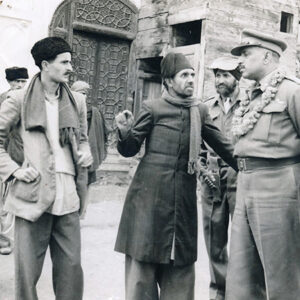
The background
The indecision by Maharaja Hari Singh, ruler of the state of Jammu & Kashmir, on the issue of aligning with India was mainly due to the pending lapse of the British Paramountcy. The decision to partition India led to the collapse of this important administrative instrument. The division of forces was to be on the basis of the formula of 2/3 (India) : 1/3 (Pakistan). The Indian Independence Act 1947 had provided that a state could conclude a “standstill agreement” with either of the dominions of both. Accordingly, the Prime Minister of Jammu & Kashmir at that time, MC Mahajan, had telegraphed Karachi and New Delhi requesting for the continuance of existing arrangements under this agreement. The Pakistan government agreed telegraphically to the standstill agreement with J&K, but it had other plans. It must be remembered that the main road to the Kashmir valley was through now what is Pakistan. (Read What exactly happened in Kashmir in 1947 – The Kashmir Document)
Soon after Pakistan came into existence it formulated plans to force the Maharaja to accede to it by strangulating the supplies and communication and by other coercive methods. Whose wisdom allowed the important Posts and Telegraphs Department to be handed over to Pakistan to run is very circumspect as the diabolical plans were already made to get to this end. To achieve this they started the armed Kabali invasion in Uri and Baramulla and simultaneously subverted the Muslim population and the state forces.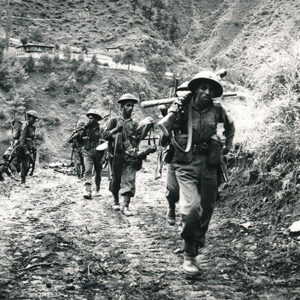
However, it was the economic blockade of the Valley which was the defining factor of this three-pronged war. There were forced food shortages, depletion, and rationing of petrol and other fuels. The postal department handling all cash transactions and banking activities were totally strangulated, thus making miserable the ordinary life of the Valley residents. The communal disturbances fuelled by Pakistan added to the travails of the state administration whose forces were distributed across the state in penny packets. Soon small numbers of people started migrations in different directions. The situation in the Poonch area became serious as the state’s ragtag force was fighting against well-armed fighters as well as the Pakistani army in uniform. This was part of the deliberate plan, as it was the pre-cursor to the large-scale invasion into the valley by “tribals”.

By around the middle of October, the state was largely incapacitated and there was no administration as such. The main attack plan was called “Operation Gulmarg” and was actually handled and signed by the head of the Pakistan Army. Each of the detachment of these tribals was commanded by a Pakistani army regular without uniform. The attacks started on 21–22 October with Muzzafarabad being the epicenter. The state forces unfortunately aligned themselves with the Kabali raiders and so this important city was over-run. Soon Domel – strategically important – was taken. There really was no resistance in between Domel and Uri. It was here that Brig Rajinder Singh, chief of the state forces, laid defenses to halt the massive invasion. Unfortunately, his motley forces could not hold the position as they were outnumbered. After retreating a number of times, the state forces were totally destroyed and the gallant Brig Rajinder Singh too fell on the outskirts of Baramulla. This town was completely destroyed, looted and raped. Many years later my good friend, Melville De Mellow, made a radio feature and called it “The Rape of Baramulla”. That radio feature brought tears to the eyes of PM Nehru and the many others who heard about the depravity of the marauders.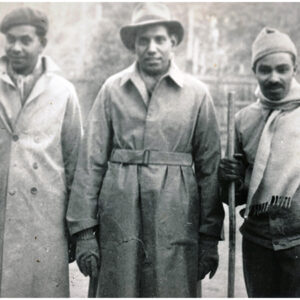
These events, as well as the overall situation being desperate, prompted the Maharaja to request the Indian Government for assistance and help. From Baramulla, the raiders had advanced to a small hamlet, Shalteng, just 5 kms out of Batmaloo, Srinagar. It was decided by the cabinet in Delhi that the Indian forces could only be sent after a written document was signed by the state ruler. It was at this juncture that the Maharaja signed the Instrument of Accession on October 26, 1947, thus paving the way for the Indian forces to begin operations. The famous battle of Shalteng on the outskirts of Srinagar is considered to be one of the defining factors in the history of Kashmir. It was by the end of December ’47 that the Indian forces were able to push back the raiders beyond Uri. There is controversy as to what led to the Indian army to withhold operations as they had the invaders running. Had the offensive continued there was little doubt that the Indian Army could have taken back Domel and Muzzaffarabad. and further even Mirpur. This mystery was neither unravelled nor debated in an open forum, ever. It is well known that PM Nehru diverted efforts to the Poonch area with instructions to hold onto that area at any cost.
The winters of 1947–48 were significant, as the defences of the Valley was bolstered and now they were a lot more prepared. In fact in May 1948 an offensive was launched to capture Domel; unfortunately, the Pakistanis were also shoring up their defences and this resulted in pitched battles but little else. Except for some minor gains, there was a stalemate. The Indian forces were numerically smaller than the determined Pakistanis with a much larger force. This emboldened the Pakistanis to choose and select some strategic targets and the result was that India ceded large swathes of territory in the Jammu area as well as the areas west of Uri. Unfortunately, the Pakistanis shifted focus to the North comprising of Gilgit, Kargil, Skardu and Ladakh.
The strategic areas of Gilgit, Skardu and Kargil were now targeted by the Pakistanis, who decided that it would put pressure on the Indian forces by opening up the Northern front apart from the already active Western front (Uri & Poonch). With the termination of the Gilgit lease in July 1947 the area which was back with the Jammu & Kashmir state forces was hardly in any shape to effectively protect these areas. The British officers holding command at Gilgit specifically were in favour of handing over this very important area to Pakistan, and as such the Maharaja simply handed it over to them as the state forces were no match for the invaders. The Indian forces which by then had arrived in the Valley were concentrated in clearing the invaders in the Uri / Baramulla / Poonch sectors.
Clearly the British sided with Pakistan, and till today people wonder about the actual motive behind this treacherous move. It must be noted that one of the two most important caravan routes to Kashgarh and beyond to China went 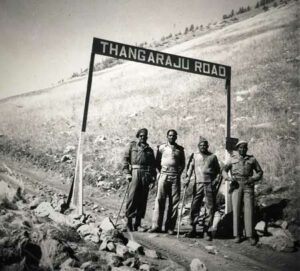 through Gilgit. The British Major Brown (Gilgit Scouts) simply asked the British political regent to send a Pakistani authority to take over as there was little or no resistance. By end of November 1947, Pakistan had complete control over the region, sweeping the local liberation front aside. The bigger game plan was to find inroads to Skardu and onwards to Leh (Ladakh). The capture of Gilgit by the scattered force, comprising of Gilgit Scouts, Chitral Scouts, the Muslims of the state forces, some locals led by Pakistani army regulars and their British commanders, raised the morale which led them to move forward to newer areas.
through Gilgit. The British Major Brown (Gilgit Scouts) simply asked the British political regent to send a Pakistani authority to take over as there was little or no resistance. By end of November 1947, Pakistan had complete control over the region, sweeping the local liberation front aside. The bigger game plan was to find inroads to Skardu and onwards to Leh (Ladakh). The capture of Gilgit by the scattered force, comprising of Gilgit Scouts, Chitral Scouts, the Muslims of the state forces, some locals led by Pakistani army regulars and their British commanders, raised the morale which led them to move forward to newer areas.
Skardu, another very strategic area, was central to the other route going to Ladakh along the Indus and it too was put in a stranglehold due to the ineffective defence put up by the ragtag state forces. The “Siege of Skardu” as it is now known had begun and went for several months. The gallant state forces fought hard but ultimately, with no reinforcements forthcoming, it was a dire situation. Only a full chapter on this battle would do justice to the bravery under sustained attacks.
Gurez, another very important gateway to the Valley and an approach route to Gilgit on the other side, saw a Pakistan-led force looking to make inroads. However, the Indian Army saw this and, in a concerted offensive effort, established control on this strategic area. In June ’48 this area was brought back into Indian control. Gurez is one of the most beautiful parts in Kashmir. Thus this route got blocked for a Pakistani advance.
The area which was now threatened was Kargil, as all reinforcements for Skardu were to go through this town. Due to many reasons the Indian forces were all spread over the route going to Kargil, and were not significant in numbers ever to mount a major offensive to oust the hostile forces. Ultimately in early May 1948, Kargil fell. The Indians were badly mauled and decimated. From Kargil they lost control of Dras region (Dras garrison was surrounded, though still in Indian control but very much isolated) and then headed towards Zoji-La, with the ultimate aim of getting to the Valley.
Ladakh was an isolated part of the state of Jammu & Kashmir but strategically very important, as it was the centre of trade routes between China and the Middle East. It was thus an important and coveted area for both Pakistan and India. The Skardu garrison having been “contained” opened the way for the Pakistan-led force to move towards Leh by way of Nubra Valley to the north and the Indus valley in the immediate south. Kargil having fallen, in the meanwhile, the enemy blocked the communication lines and passage between Srinagar and Leh, adding to the problems of the small defensive positions of the State and Indian Army. With no path left for the forces to move forward and to reinforce areas around Leh, the only option left was by way of air. A landing strip was made hastily and in May 1948 the first aircraft landed in Leh. I was present in Leh at that historic event when the famous Air Commodore Mehar Singh and Gen Thimaya landed. Soon reinforcements were flown in and the situation was retrieved in the nick of time. Ladakh was saved.
Thus, the inroads made by the enemy forces to get to the Kashmir valley were halted in Gurez, Uri and Baramulla by now. Ladakh too was under Indian control, where the Indians started pushing back the hostile forces all the way beyond along the Indus Valley. Thus the Pakistani forces had only Zoji-La as the path left to get to the Valley. They orchestrated concerted attacks all along the Valley route leading to Sonamarg, along the river Sindh. Several bridges over this river 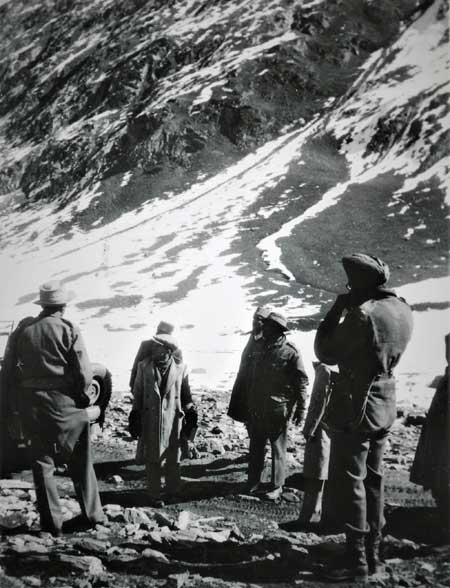 were targeted and one such battle was fought at the Wyil bridge on the outskirts of Ganderbal (short of the small town of Kangan). I was present at the bridge and have reported first-hand on the skirmishes there, as a war correspondent. The raiders were not any “mujahideen” but regulars of the Pakistani army dressed as raiders. Several who lay dead in the fields beyond the bridge even had their army ID cards with them.
were targeted and one such battle was fought at the Wyil bridge on the outskirts of Ganderbal (short of the small town of Kangan). I was present at the bridge and have reported first-hand on the skirmishes there, as a war correspondent. The raiders were not any “mujahideen” but regulars of the Pakistani army dressed as raiders. Several who lay dead in the fields beyond the bridge even had their army ID cards with them.
For many months during the summer of 1948, the Indian Army made efforts to dislodge and push back the Pakistanis from the heights around Zoji-La. Almost all the attempts yielded no results. The commanders came to the conclusion that if the enemy was not pushed out of Zoji-La area before the winter set in, it would become impossible to keep them from rolling into the Kashmir valley after the snow melted the next spring. They envisaged that if this did happen then the whole of Ladakh would be cut off from the Kashmir valley and perhaps be lost forever. This was a very scary thought and unacceptable to the country.
The stage was set for a deciding battle. It must be put into perspective that by then the road from Kargil to Dras and onwards to the Zoji-La top – known as the Gumri basin – was under the effective control of the Pakistani forces. In May 1948 the first organised force of the Indian army, the Patiala regiment, was ordered to go to Sonamarg, Baltal and Zoji-La. This regiment was later to be the most highly decorated as they took part in several important battles. In mid-May one such battle pushed the enemy from Gumri towards Dras. This established two objectives – the effective control of the path on Zoji-La and re-establishing the lines of communication from Srinagar to Sonamarg and onwards to Dras via Zoji-La. In June several attacks by the enemy forces were repulsed but they gained ground by reaching the top of the hills around and thereby gaining commanding positions overlooking the complete pass. They soon started beefing up their positions with heavy artillery and also to outflank the Indian positions. Sheer numbers were against Indians but they held positions very bravely and against all odds.
Between June and July major attacks from the enemy established the fact that with such intensity and use of heavy artillery, it was indeed the enemy regulars who were fighting and not “raiders”. Gen Thimaya who was in charge of the entire Valley approved of the organised withdrawal of the forces from Machoi and Gumri to Zoji-La. While it was a tactical move, it meant giving up some very strategic locations in the surrounding hilltops. In the meanwhile traffic on the Srinagar to Sonamarg was restored in July. Plans were afoot to regain control of Dras and Kargil as well as Skardu.
An aborted attempt to find a second route via the Muskoh valley forced the top Indian army brass to have a rethink and make new plans to go through Zoji-La, Gumri and Dras to Kargil. Yet another attempt to go for a three-pronged attack too did not yield results, and with heavy losses the Indians had to retreat. The consequence of the Indian forces not making much headway was actually felt on the Ladakh area, as with a (now) large force, stocking up of rations and ammunition was necessary with winter approaching. The Manali route was decidedly more difficult and prone to closure due to early snow. In September ’48 at a high level meeting under Gen Cariappa it was decided to use heavy tank artillery to push through. That was easier said than done, as the small bridges en route from Jammu area to Sonamarg were a big problem for such heavy equipment. Not only that, there was practically no road beyond Baltal (at the base of Zoji-La) – it was at best a jeepable road and getting heavy tanks to go up the steep tracks would be nearly impossible without being undetected. On two to three occasions I had observed Gen Thimaya toying with this idea and wondering aloud as to how it could be done. I recall that sometime in the end of September Sheikh Abdullah had visited Gurez along with Gen Thimaya and while driving back (I was in the same vehicle) it was disclosed that the proposal to use tanks at Zoji-La was being favourably considered by the military HD in Delhi.
In this background, certain important incidents take on their own significance. First and foremost was how to get the tanks from the plains into the mountains and up to Zoji-La, without disclosing the surprise part of it. Second was how to get the tanks up from Baltal (at the foot of Zoji-La) to the top of the pass (because there was no road beyond Baltal) and the mountainside was unstable and steep. Third was the condition of the ground on both sides of the pass, which had never been tested for heavy weights and no one knew whether the tanks would be able to move on or get bogged down. Having got the tanks dismantled in the Jammu plains, they were transported only during the nights to Baltal and reassembled at the other end. The surprise was kept. Gen. Thimaya devised that an armoured carrier was given heavy plating to bring it to the level of the weight of the Stuart tank which was to be put as the vanguard vehicle so if it sinks into the marshy ground, real tanks would not be lost.
It was in the last week of September that orders were given to 7th Cavalry to move from Akhnoor to Srinagar. Speed and secrecy was of paramount importance. The next challenge was to find a way to make the jeep path drivable for these heavy tanks. Anyone who has been to Zoji-La knows that though it is one of the lowest passes in the Himalayas at 11572 ft., it receives the highest amount of snowfall. I have personally driven through walls of about 93 ft of snow here. Usually the snow starts by the beginning of October, and under extreme cold conditions this is one of the most inhospitable areas.
The question of the road between Baltal and Zoji-La continued to be a problem till an officer of the Engineers came forward to complete the task within the timeframe. Eight kilometers had to be cut, widened and made fit for movement of tanks. So the work was started in the middle of September, and the additional labor force was available only a month later. Due to the enemy being able to watch everything from the heights, work could be undertaken only in the dark. It took more than 30 days to make a road of 9-mile length with a comfortable gradient, which could take the tanks with tracks. The task was accomplished by good coordination under the able and inspiring leadership of Major M.A. Thangaraju. Appropriately, this road was named after him and continues to be known as such. Now only traces of the original road are left. On this road, ultimately eleven Stuart tanks of the 7th Cavalry went up to Zoji-La and beyond to Gumri Basin. The tank drivers were brave, courageous soldiers and the commanders were able to provide leadership, inspiration and good coordination, teamwork and total commitment, which resulted in the complete success of the venture, and created history.
With everything in place for the final assault, Gen Thimaya and senior officers reached Baltal in the third week of October to oversee the operations. At Baltal there was a two-room forest hut which became the headquarters of Gen Thimaya for the Zoji-La operation. The hut had been used in 1916 by Pandit Nehru and his wife Kamala for their honeymoon. Gen Thimaya was able to retrieve the tourist register with Nehru’s comments and signatures. Thereafter, there has been no trace of the register.
One of the two rooms was used by Gen Thimaya; the other room was kept for visiting commanders. For the crucial days of the tank breakthrough, three war correspondents were allowed to stay there. Apart from me, were K.L. Sharma of AIR and Wilfred Lazrus of PTI (API). Gen Thimaya had a Second World War vintage Helicrafter Radio Receiving Set and was fond of surfing. On the night of 1st November, he picked up the local enemy commander of Zoji-La reporting to the Pakistani Brigade Commander that Indians had brought tanks and dislodged them from heights. The Pakistani Brigadier disbelievingly told him that it was impossible, these must be camouflaged jeeps. The General immediately decided that in future briefings and signals, they would use only this phrase for tanks and this façade would be kept up till the end of the operations. The war correspondents were also told to avoid use of words like tanks and armor. In the meantime, the first-day dispatches had gone across and some were published in London newspapers. We were informed later that the Indian High Commission in London had asked the Defence Ministry in Delhi to restrain Indian war correspondents from reporting “cock-and-bull stories”. The world did not seem to believe that the Indian Army could operate tanks at those heights and under those conditions! We continued to use “camouflaged jeeps” for tanks till the liberation of Kargil on 24th November: when the whole story was published and it established the facts for all time.
Unfortunately, the weather turned very poor with snow and rain. Some saw this as a silver lining as it gave time to revise and go over plans in a much more detailed way. Some of the earlier attempts were wasted due to hasty operations without proper planning, and more importantly adjustment of troops to the harsh weather and height. Finally, on November 1, the orders were given to start the ascent to the main pass from Baltal. Eleven tanks were used for the first time ever on such difficult terrain, so much so that in the final stretch they were winched up. Led admirably by a young Capt Jamwal, the tanks finally reached the flatter grounds of the pass and Gumri Basin. The guns opened up and with the element of surprise and superior firepower in the favor of the 7th Cavalry, by mid-afternoon, the enemy had abandoned their posts. The tanks fired and completely destroyed the foxholes made by the enemy. Although the tanks were able to break through Zoji-La in one day (November 1) they got held up in the next week at the two other places, Machoi and Malayan.
Finally, our troops were held up below the Batkundi Ridge because of the enemy having taken strong positions overlooking the valley below. We were stuck there for almost one week. Surprise attacks around Anant Ridge and Brown Hill were mounted by Indian troops. Senior Generals of Indian forces spent the final night with the troops under open skies, which boosted the troops’ courage and camaraderie. Then, on November 14 the tanks and the troops were able to push through to Drass (reportedly the second coldest inhabited place in the world). Next day was Guru Nanak Dev’s birth anniversary and as the Indian troops were led by soldiers of the 1st Rajinder Infantry of Patiala, the Sikh troops celebrated it in a big way. A day later the GOC arrived along with the press, and celebrations took place. That night, Gen Thimaya was fiddling with his radio set and he picked up a conversation between a Pakistani Commander and one “Major Ishaq” – perhaps a code name. Ishaq reported that he had come into Drass the previous night, enjoyed celebrations with the Sikh troops, visited his hideout, collected all his papers and documents and returned safely to Mushko valley, under cover of darkness. Gen Thimaya highly appreciated this daredevil feat of the Pakistani officer.
One breakthrough after another eventually led to the liberation of Kargil, and the final linkup with Leh garrison happened. In the Nubra valley too, the infiltrators were pushed back. It is pertinent to point out that without the decisive and dramatic battle of Zoji-La, the map of Kashmir would be without Kargil, most of Ladakh, and who knows perhaps the Valley itself. November 1948 must be remembered as the month when India reclaimed a lot of lost ground and will surely be known for the Battle of Zoji-La amongst many other important battles.
The tank breakthrough of November 1948 in Kashmir was an epoch-making event and opened a new chapter in the military history of the world. Never before had armoured vehicles like tanks, armoured cars etc. operated at such heights and in such trying climatic conditions. The tank manufacturers had never envisaged that armour would be used at those heights under those conditions. They were conceived and manufactured for operation on mostly level ground and the plains.
(A few weeks earlier the French photographer Henri Cartier Bresson, who had become a good friend, had given me his last color film before leaving since I was the only photojournalist around. I had never used color film before and was miserly in using it. After exposure, the film had to be sent to Paris for processing and came back to me after a couple of weeks. However, the first shots on Duafaycolor were taken by me at Gumri Basin of the first tanks that got across Zoji-La.)
On one of my trips from Srinagar to Zoji-La in June 1948, I was waiting at the TCP (Traffic Control Point) at Nilgrad little beyond Sonamarg when I saw a Balti porter carrying an injured soldier in a homespun blanket. On inquiry, I learned that this was the second solider that this porter Mohammad Ismail had brought down in seriously injured condition from an army piquet high up on the cliffside. I was told that due to enemy firing, soldiers in our piquet had been wounded and they were in no condition to come down on their own. Only a daredevil volunteer from down below could go up and help to bring the injured down because the entire cliff face was under enemy observation and hence under fire. I instantly sat down and got all the details from him and got a photograph. This is the only photograph available anywhere of this daredevil porter. When the Ismail story was published it received notice in the right quarters and his name was recommended for being awarded the Maha Vir Chaka. It is interesting to note that this perhaps is the only instance of a civilian being awarded a military medal of this level. Later he was taken prisoner by the enemy on September 13 in Chabutra area. He, however, escaped from their custody and was able to join the celebrations on November 15 for the liberation of Drass. Ismail was forgotten and lived a quiet life in his village for many years to come. In the early nineties, I learned that Pakistani armed militants had shot him dead. It’s a pity that we are not even able to take care of our well-known heroes.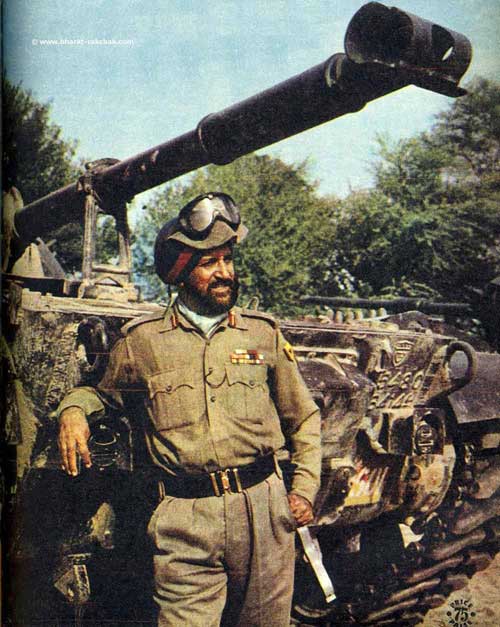
The parleys at the United Nations finally brought about a ceasefire on January 1, 1949, and the actual ground position was demarcated as the ceasefire line and later converted to Line of Control. It is well known that India’s posturing amongst the Western governments and at the UN Security Council left much to be desired whereas Pakistan made a very forceful presentation and courted these governments. It was clear to the Indian government that the powers-to-be of the Western world were against the Indian position and should have continued to engage with them while the military commanders cleared the occupied Kashmir, Skardu, Gilgit and the other Northern areas. There was a view within the military establishment at that time that there was a deliberate lack of information between the Indian government and the military leadership on this. The top military brass was surprised that India had accepted the ceasefire effective January 1, 1949. I am sure that had the military commanders known of what was going on, there would have been a totally different result and the actual ceasefire line would be much more in favor of India. In fact, I had several conversations to that effect with Gen Thimaya as I was part of a small group which took the UN observers to the ceasefire line along with Gen Thimaya (see photo with them).
As we are aware, this issue has not been resolved till date and is the main bone of contention whenever the “Kashmir problem” is debated between the two countries. That is why even today India is not willing to accept the Line of Control as the internal border.
Tacit complicity of the British forces in aiding the Pakistan cause is also well known. Gen Gracey (who was the Commander in Chief of the Pakistani forces) did not hide this and in fact, there are instances when the British Indian establishment acted in concert with him and ensured that the Uri to Nowshera line was not breached by the Indian military. Why else would there be a total reversal of orders when the Indians were in hot pursuit to recapture Domel and Muzaffarabad? Had that happened, the Indian Army would have driven out the Pakistanis from the Poonch and Nowshera area as they would have been outflanked. I am told that only a few senior British Indian officers took this decision and the Indian defense establishment was not aware of it. Sardar Patel was furious about this blatant bias towards Pakistan and insisted that Field Marshal Auchinleck be relieved of command and control to be given to the Indians. Many years later when records were declassified it was found that the British Indian officers and the British government, through its High Commissioner, had totally different plans – basically to limit the Indian forces’ march to regain ground.




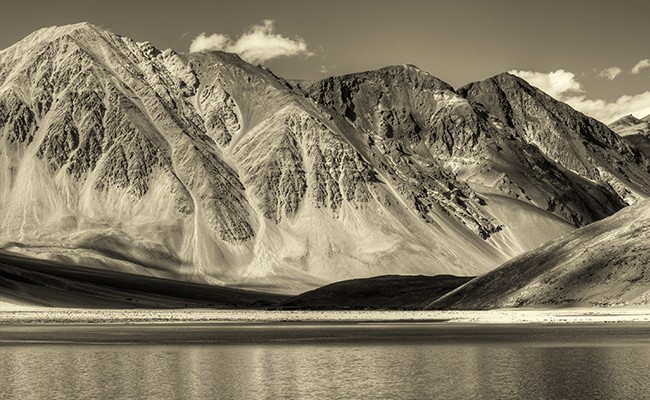





Very informative and inspiring.
Its significance can be better understood if one has been to few of these areas, and experienced the difficulty of the terrain.
Kudos to the Indian army and their patience.
Very informative. I feel this should be included in the school syllabus and correct things should be taught to the students. This article tells you what is Kashmir problem.
बेहतरीन लेख लेखक का। सुंदर प्रस्तुति मैगजीन की।
इसे आज की कश्मीर समस्या के सन्दर्भ में देखें तो कुछ खलनायक और कुछ परिस्थितियों का खुलासा होता है। पहले खलनायक +++महाराजा हरिसिंह और उसके प्रधानमंत्री एम सी महाजन। अदूरदर्शी नीतियों और गलत निर्णय के जनक। दूसरे खलनायक**** ब्रिटिश सरकार,उसके, आफिसर,हाईकमीशनर, फील्ड मार्शल अचिन लेकिन,जनरल जी ग्रेसरी,( सी इन सी पाकिस्तान))
मेजर ब्राउन (गिलगित स्काउट्स) । तीसरे खलनायक ######## जवाहरलाल नेहरू,शेख अब्दुल्ला ,०१-०१_१९४९ (कश्मीर का काला दिन) को आगे बढ़ती भारतीय फौजौ को रोक सीजफायर एक्सेप्ट किया। हालांकि इसे विवादित,और रहस्यपूर्ण विषय मानकर ठन्डे बस्ते में डालने के प्रयास किये बजाय इसे खुलासा करने या इस पर बहस करने के ।
हमारे देश के ज्यादातर नेता ,या तो इंग्लैंड पास वकील थे या आंदोलनों के कर्ता धर्ता ,जिन्हें प्रशासन चलाने की कोई समझ नहीं थी , आजादी के बाद के कर्णधारों ने अदूरदर्शिता और व्यक्तिगत अहंकार के चलते जो गलत निर्णय लिये उसे आज का भारत भुगत रहा है ।सबसे बड़ा धर्म के नाम पर देश का विभाजन, उसके बाद आजाद भारत का प्रथम गवर्नर जनरल ,, माउंटबेटन,पहला फील्ड मार्शल सी इन सी अचिन लेक और बड़ी लम्बी लिस्ट है क्या भारत के पास अच्छे जनरलों या प्रसानिक अधिकारी नहीं थे ,या जानबूझ कर उन्हें साईड लाईन किया गया । सडी गली ब्रिटिश पुलिस , शिक्षा , न्याय व्यवस्था को ही अपनाया गया जबकि विश्व के ज्यादातर देशों ने ब्रिटिश शासन से मुक्ति पाते ही उनकी व्यवस्था को जड़मूल से उखाड़ कर फेंक दिया और स्वदेशी व्यवस्था को अपनाया। यही भारत के दुर्भाग्य का कारण बन गया है,जिसमें देश में एक भाषा एक कानून नहीं है।
I have spent months from 1985 to 1989 in somnath when youth Hostel organized Laddakh trekking program. I have crossed Zozila many times and surprised that in 1948 Tanks were used. Unbelievable but our army have done it. Hats off to Indian army.
I have spent months from 1985 to 1989 in sonmarg when youth Hostel organized Laddakh trekking program. I have crossed Zozila many times and surprised that in 1948 Tanks were used. Unbelievable but our army have done it. Hats off to Indian army.
Half truths have been mentioned.Nothing has been said about killings and displacement of hundreds and thousands of of Muslims from Jammu and Kashmir by the Dogra forces in 1947.Contrary to what had has been mentioned as pro-Pakistan bias by the British Army officers,it is widely believed in Pakistan that British Army was tilted towards India,because Mountbatten had been retained by India as Governor-General after 1947,Field Marshal Auchenik Who was Supreme Commander of Both Pakistan and Indian Army didn’t follow orders of Mr Jinnah when he desired that Army launch move against India in Kashmir and he threatened to withdraw British Army officers from Pakistan.Lets not distort history and tell the truth for our future generations.
What a comprehensive account of those difficult situations. It is unfortunate to have Indian political brass to be not caring for Indian interests as much as they took steps which favoured enemy outright. Less said better it will be except to look for implementing remedial strategized measures along with pressures and appropriate timely parallel communications with international powers, only for information.
What Muslim Pakistan did in Muslim majority Kashmir was diabolical, what about what Hindu India did in Hyderabad Decan.
These are actually wonderful ideas in about blogging. You have touched some
pleasant factors here. Any way keep up wrinting.
I could not resist commenting. Exceptionally well written! I am sure this piece
of writing has touched all the internet visitors, its really
really fastidious piece of writing on building up new blog.
http://house.com/
Really wonderful reporting….hats off to the Indian Armed Forces and Md Ismail …for such bravery…
When someone writes an article he/she keeps the image of a user in his/her brain that how a user
can be aware of it. Thus that’s why this piece of writing is great.
Thanks!
I’m not sure where you’re getting your information, however good topic.
I needs to spend some time finding out more or understanding more.
Thanks for excellent information I used to be searching for this information for my mission.
Thanks, this site is very valuable.|
Very well written and useful. I like the concept of this website a lot. Thanks for keeping us connected. Regards
Comments are closed.